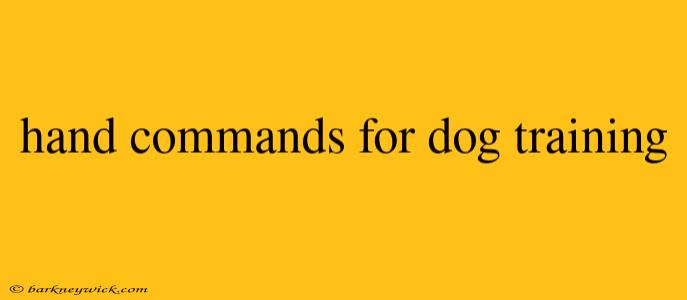Mastering the Basics: Hand Commands for Dog Training
Remember that time you tried teaching your dog to sit, but all you got was a confused look and a wagging tail? We've all been there. Dog training can be a fun and rewarding experience, but it can also be a bit frustrating if you don't have the right tools and techniques. One of the most important elements of dog training is using hand signals. They provide a silent, consistent way to communicate with your furry friend, allowing for clearer and more effective training sessions.
My Experience with Hand Signals:
As a dog owner myself, I've learned the importance of hand signals firsthand. My Labrador Retriever, Max, used to get distracted by squirrels and other passing creatures during walks. Using only verbal commands, it was almost impossible to regain his attention. Then I discovered the power of hand signals. By pairing a hand signal with a verbal command, Max quickly learned to associate the hand movement with the action, making training sessions much more productive and enjoyable for both of us.
Why Hand Commands are Essential:
Hand signals are crucial for several reasons:
- Clarity and Consistency: Dogs can't understand human language in the same way we do. Hand signals provide a visual aid that reinforces verbal commands, creating a clearer understanding of what you're asking.
- Distance Communication: You can use hand signals from a distance, which is especially helpful for commands like "come" or "stay" when your dog is a few feet away.
- Distractible Dogs: If your dog is easily distracted, hand signals can help cut through the noise and provide a focused cue.
- Training Versatility: Hand signals can be combined with verbal commands and even clicker training for even more effective communication.
Popular Hand Signals for Dog Training:
Here are some common hand signals used in dog training:
- Sit: Hold your hand with your palm facing your dog and move it slowly upwards towards their nose.
- Stay: Hold your hand up with your palm facing forward. This signal is often combined with the word "stay."
- Down: Hold your hand with your palm facing the ground and move it downwards towards the ground.
- Come: Extend your arm towards your dog with your palm facing upwards, beckoning them to come closer.
- Leave It: Hold your hand flat out in front of your dog, palm facing them, as if you are pushing them away.
Training Tips for Success:
- Consistency is Key: Always use the same hand signal for each command to avoid confusion for your dog.
- Start Simple: Introduce one hand signal at a time and practice it until your dog understands it well.
- Positive Reinforcement: Reward your dog with treats, praise, and affection for following your commands.
- Make it Fun: Training sessions should be enjoyable for both you and your dog. Keep them short and engaging.
- Use the Right Tools: Consider using a clicker to mark desired behavior, making training even more efficient.
The Power of Positive Reinforcement:
It's important to remember that positive reinforcement is the key to successful dog training. Instead of using punishment or harsh methods, focus on rewarding good behavior and praising your dog for their efforts.
Entity: The American Kennel Club (AKC)
The AKC is a renowned organization that sets standards for dog breeds, promotes responsible dog ownership, and provides resources for dog training. You can find useful information on their website, including articles and videos about hand signals and other training techniques.
Conclusion:
Learning to use hand signals can transform your dog training journey. By combining hand signals with verbal commands and positive reinforcement, you can build a stronger bond with your dog and foster a more responsive and obedient companion. Just remember, patience and consistency are your allies in this process. With dedication and positive reinforcement, you and your furry friend will be mastering hand commands in no time!
